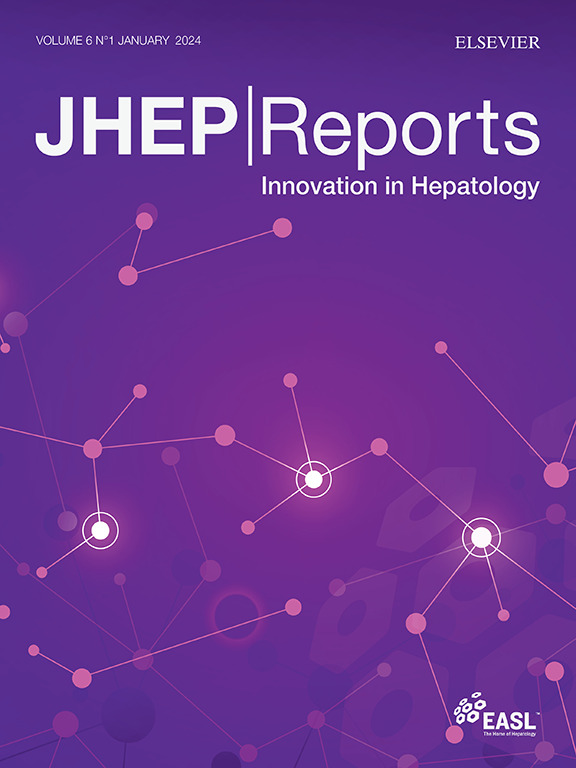ECM1 expression in chronic liver disease: Regulation by EGF/STAT1 and IFNγ/NRF2 signalling
IF 7.5
1区 医学
Q1 GASTROENTEROLOGY & HEPATOLOGY
引用次数: 0
Abstract
Background & Aims
The extracellular matrix protein 1 (ECM1) is essential for liver homeostasis by keeping latent transforming growth factor-beta quiescent. Upon hepatocyte damage, ECM1 is significantly downregulated, facilitating fibrosis and chronic liver disease (CLD) progression. We investigated the mechanism of ECM1 regulation in hepatocytes under pathophysiological conditions.
Methods
We used promoter analysis to predict Ecm1 transcriptional regulators and assessed the expression of Ecm1-related genes by single-cell RNA sequencing (scRNA-seq) and bulk RNA-seq. Functional assays were performed with AML12 cells, mouse and human primary hepatocytes, and liver tissue from mice and patients.
Results
In healthy hepatocytes, epidermal growth factor (EGF)/EGF receptor (EGFR) signalling sustains ECM1 expression through phosphorylating signal transducer and activator of transcription 1 (STAT1) at serine727 (S727), thus enhancing its binding to the ECM1 promoter and boosting gene transcription. This process is disrupted during liver inflammation by interferon gamma (IFNγ), which downregulates EGFR and inhibits EGF/EGFR/STAT1-mediated ECM1 promoter binding. Mechanistically, IFNγ-induced STAT1 phosphorylation at tyrosine701 (Y701) impairs the binding of p-STAT1 S727 to the ECM1 promoter. Additionally, IFNγ induces nuclear factor erythroid 2-related factor 2 (NRF2) nuclear translocation, which repressively binds to the promoter of ECM1, further reducing its expression. These findings are confirmed in several CLD mouse models (n = 2–6). Moreover, AAV8-ECM1 attenuates liver fibrosis and injury in Western diet-fed mice (n = 8–10), counteracting the effects of EGF signalling inhibition and IFNγ/NRF2 activation. In CLD patients (n = 22), ECM1 levels correlate positively with EGFR expression (p <0.0001) and negatively with IFNγ/NRF2 activation (p <0.0001).
Conclusions
EGF/STAT1 signalling promotes whereas IFNγ/NRF2 inhibits ECM1 expression in hepatocytes in health or disease, respectively. ECM1 has the potential to be developed as an antifibrotic agent, particularly in inflammation- or reactive oxygen species-driven CLD.
Impact and implications
This study reveals the regulatory mechanism of ECM1 in hepatocytes, demonstrating that EGF/STAT1 maintains ECM1 expression to prevent fibrosis, whereas IFNγ/NRF2 signalling inhibits ECM1 during chronic liver inflammation, thereby accelerating disease progression. These findings are important for researchers and clinicians to understand the pathogenesis of liver fibrosis, especially in CLD driven by inflammation or oxidative stress. Clinically, ECM1 levels correlate positively with EGFR expression and negatively with IFNγ/NRF2 activation, providing potential antifibrotic targets for CLD patients.

慢性肝病中ECM1的表达:EGF/STAT1和IFNγ/NRF2信号的调控
背景,目的细胞外基质蛋白1 (ECM1)通过保持潜伏的转化生长因子- β的静止而对肝脏稳态至关重要。在肝细胞损伤时,ECM1显著下调,促进纤维化和慢性肝病(CLD)进展。我们研究了病理生理条件下ECM1在肝细胞中的调控机制。方法采用启动子分析预测Ecm1转录调控因子,并通过单细胞RNA测序(scRNA-seq)和整体RNA测序(bulk RNA-seq)评估Ecm1相关基因的表达。用AML12细胞、小鼠和人原代肝细胞以及小鼠和患者的肝组织进行功能测定。结果在健康肝细胞中,表皮生长因子(EGF)/EGF受体(EGFR)通过磷酸化丝氨酸727 (S727)处的信号传导和转录激活因子1 (STAT1)来维持ECM1的表达,从而增强其与ECM1启动子的结合,促进基因转录。这一过程在肝脏炎症期间被干扰素γ (IFNγ)破坏,干扰素γ下调EGFR并抑制EGF/EGFR/ stat1介导的ECM1启动子结合。从机制上讲,ifn γ诱导的酪氨酸701位点(Y701)的STAT1磷酸化会损害p-STAT1 S727与ECM1启动子的结合。此外,IFNγ诱导核因子红系2相关因子2 (NRF2)核易位,抑制结合ECM1启动子,进一步降低其表达。这些发现在几个CLD小鼠模型中得到了证实(n = 2-6)。此外,AAV8-ECM1减轻了西方饮食小鼠的肝纤维化和损伤(n = 8-10),抵消了EGF信号抑制和IFNγ/NRF2激活的作用。在CLD患者(n = 22)中,ECM1水平与EGFR表达呈正相关(p <0.0001),与IFNγ/NRF2激活呈负相关(p <0.0001)。结论在健康或疾病的肝细胞中,segf /STAT1信号分别促进ECM1表达,而IFNγ/NRF2抑制ECM1表达。ECM1有潜力成为一种抗纤维化药物,特别是在炎症或活性氧驱动的CLD中。影响和意义本研究揭示了ECM1在肝细胞中的调控机制,表明EGF/STAT1维持ECM1表达以防止纤维化,而IFNγ/NRF2信号传导在慢性肝脏炎症期间抑制ECM1,从而加速疾病进展。这些发现对于研究人员和临床医生了解肝纤维化的发病机制非常重要,特别是在由炎症或氧化应激驱动的CLD中。临床上,ECM1水平与EGFR表达呈正相关,与IFNγ/NRF2激活负相关,为CLD患者提供了潜在的抗纤维化靶点。
本文章由计算机程序翻译,如有差异,请以英文原文为准。
求助全文
约1分钟内获得全文
求助全文
来源期刊

JHEP Reports
GASTROENTEROLOGY & HEPATOLOGY-
CiteScore
12.40
自引率
2.40%
发文量
161
审稿时长
36 days
期刊介绍:
JHEP Reports is an open access journal that is affiliated with the European Association for the Study of the Liver (EASL). It serves as a companion journal to the highly respected Journal of Hepatology.
The primary objective of JHEP Reports is to publish original papers and reviews that contribute to the advancement of knowledge in the field of liver diseases. The journal covers a wide range of topics, including basic, translational, and clinical research. It also focuses on global issues in hepatology, with particular emphasis on areas such as clinical trials, novel diagnostics, precision medicine and therapeutics, cancer research, cellular and molecular studies, artificial intelligence, microbiome research, epidemiology, and cutting-edge technologies.
In summary, JHEP Reports is dedicated to promoting scientific discoveries and innovations in liver diseases through the publication of high-quality research papers and reviews covering various aspects of hepatology.
 求助内容:
求助内容: 应助结果提醒方式:
应助结果提醒方式:


